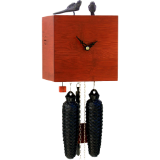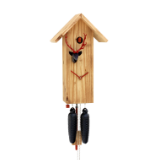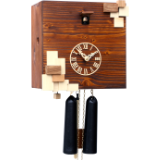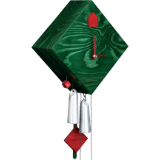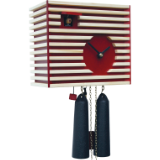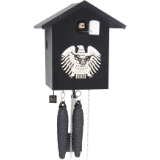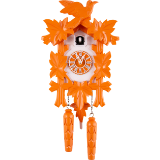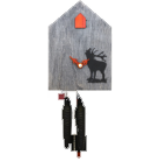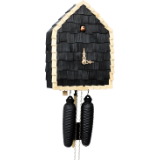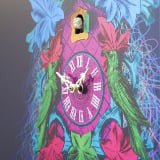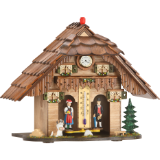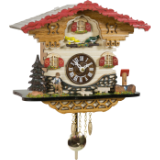The Black Forest cuckoo clock in the past and today
Variations of cuckoo clocks today
The models most closely resembling the more geometric original form are those that fall under the collective term "traditional carved clocks". The "Häusel" is almost always surrounded by a multi-leaved vine. Birds or hunting motifs complete the decoration.
The cuckoo clocks known as "chalet clocks" also have their "Häusel". This is usually designed as a traditional Black Forest house or farm, with windows, often hand-carved roof shingles, flower boxes and other decorative accessories. It also stands on a pedestal, sometimes rustic, sometimes lavishly decorated with nature scenes or other motifs.
There are 1-day cuckoo clocks and larger clocks with an 8-day power reserve. Many of the larger clocks are also equipped with high quality mechanical music rolls. These clocks have a third chain movement and therefore a third weight that drives the music roller. In addition to the music, dancers move on a rotating disc below the cuckoo door. Such elaborate masterpieces of the art of clockmaking often have other moving elements. Traditional motifs such as mill wheels, moving sawmills or beer garden scenes are particularly popular. Small miniature worlds come to life every hour on the hour on the clock platform. Of course, in addition to mechanical clocks, cuckoo clocks with quartz movements and digitally generated cuckoo calls/music are also available today in all sizes and variations. The weights and pendulums are just dummies, but the design of the cases and decorative elements is also pure handicraft.
Modernity has also arrived. In recent years, there has been a small boom in cuckoo clock models, most of which still have the cottage and cuckoo and the tried and tested mechanism, but with a modern design. Bright colors or strict geometry and the use of typical traditional decorative elements in a new design creatively challenge and reinterpret the term "cuckoo clock".
Since Black Forest cuckoo clocks are such a popular souvenir, there are also various so-called souvenir clocks for smaller budgets. Usually, these are quartz clocks, but there are also clocks with spring-wound mechanism. There are small clocks without a cuckoo, but with a cuckoo call, larger clocks with a bird and clocks with a quarter call, where the cuckoo calls every quarter of an hour.
Background to cuckoo clock making
Cuckoo clock making requires a lot of experience and craftsmanship. The amount of handwork does not make a cuckoo clock unique, but it is far from being a mass-produced item. Cuckoo clock manufacturers are not fixated on producing cuckoo clocks at the lowest possible price, but are committed to high standards of quality and tradition. Some of the manufacturing processes are centuries old and have been passed down from generation to generation of Black Forest clock makers.
In order for a cuckoo clock to reach the customer in the quality they are accustomed to, many steps are required. Specialists in various trades are entrusted with the individual operations to ensure that the quality standards are met. Most manufacturers of Black Forest Clocks have their own carpentry and carving workshops and consistently rely on their own employees.
The first step is to select the right wood. This is usually the local lime tree. The cuckoo clock wood is roughly cut to size and dried for several years. Only well dried wood ensures that the wood does not warp after production. It is also much easier for the carver to work with dry wood. The well-dried wood is cut into pieces of the right size for each Black Forest Clock. A thorough quality control of the wood takes place at this stage. Pieces of wood with rough irregularities are sorted out so that no cracks can appear later.
One of the most important parts of the cuckoo clock is the front. It is the figurehead of each clock and takes a large part of the working time. Experienced woodcarvers skilfully execute the motif. If you look closely at the clocks, you can see the typical knife marks that only hand-carved clocks have. The roofs are often covered with handmade shingles. Each shingle of the cuckoo clocks is laid individually. The figurines are also hand-carved and can be rustic or filigree, depending on the style of the workshop. There is a cuckoo clock to suit every taste.
Another important part of every cuckoo clock is the mechanical clockwork. This is also made in the Black Forest and is precise and durable. The movement is the heart of the inner workings of a cuckoo clock and is built into the case along with the other mechanical components. A clockmaker makes the connection between the movement and the moving parts (e.g. hands, cuckoo, dancing couples or figures).
Each mechanical cuckoo clock is of course thoroughly inspected and tested for at least 24 hours before being dispatched. We hope you enjoy browsing through the diverse world of our cuckoo clocks!
